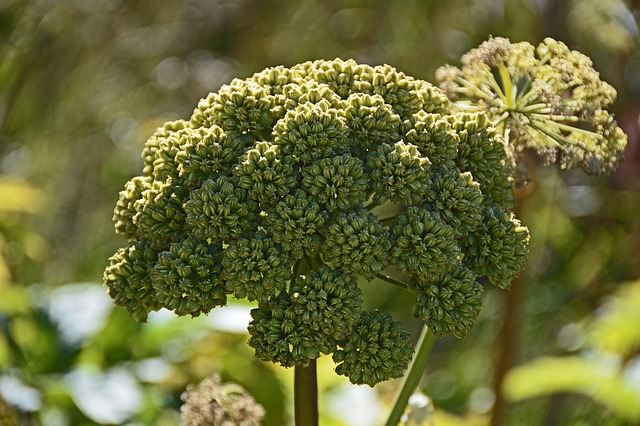 |  |  |  |  |
 |  |
A powerful biennial, less commonly perennial, herbaceous plant with a pleasant aroma, reaching a height of 1–2.5 meters. The rootstock is thick, radish-shaped, with numerous adventitious roots, containing a whitish or yellowish milky sap, and has a fairly strong sweet-spicy aroma and a slightly bitter taste. In the first year of life, a basal rosette with a small cluster of leaflets forms; in the second year, large leaves grow and a tall hollow stem appears, which is branched in the upper part, glabrous, with a bluish bloom. The leaves are alternate, sheathing, thrice pinnate; the basal leaves are large, long-petioled, and triangular in outline. The flowers are small, inconspicuous, whitish or yellowish-greenish, gathered into large spherical inflorescences — compound umbels (8–15 cm in diameter); the peduncles are densely pubescent in the upper part. The flower formula of angelica is *K5C5A5G(2).
The fruit is a schizocarp, splitting into two mericarps. It usually blooms in the second year of life from June to August. The fruits ripen from July to September.
Raw Material Harvesting
For medicinal purposes, the roots are primarily used, less often the leaves and seeds. When collecting raw materials, it is important to correctly identify the plant, as it resembles some poisonous species of the Apiaceae family. Special attention should be paid to the integrity of the plant, since damaged raw material loses its healing properties. The raw material is harvested in late autumn, in September–October, using first-year plants. Harvesting of second-year plants takes place in March–April. Angelica roots are dug up, shaken off from the soil, and the above-ground part of the plant is cut off. The roots are washed in cold water, cut lengthwise, and hung to dry. Drying is done outdoors or in an attic, or in drying chambers at 35–40 °C. Leaves are collected during the flowering phase and dried outdoors. The harvested raw material is stored in airtight cardboard boxes or bags for up to 2 years. For use as a spice, roots are dug up during fruit ripening. Inflorescences are tied into bundles and partially dried to thresh the seeds. The raw material is dried in the same way. The finished raw material consists of reddish-gray cylindrical ring-shaped sections of rhizomes with roots growing from them. The raw material has a strong aromatic smell that intensifies when crushed, and the taste is spicy, slightly bitter, and mildly pungent. Seeds and roots are also stored in airtight containers, especially the roots, which easily absorb moisture and lose their aromatic properties.
Chemical Composition
All parts of the plant contain up to 1% essential oil. The essential oil consists of monoterpenes such as phellandrene, pinene, borneol, and cymol; terpenoids; coumarins including osthol, osthenol, umbelliprenin, xanthotoxin, imperatorin, angelicin, archangelicin, and umbelliferone; and phthalic acid derivatives like ligustilide and sedanolide. Polyacetylenic compounds found in angelica oil include falcarinol and falcarindiol. Coumarins such as pinene, osthol, and furocoumarins—angelicin and other furocoumarins like xanthotoxin, psoralen, bergapten, and oxypeucedanin—are also present. The plant contains phytosterols, resins (6%), wax, bitter and tannin substances, organic acids including malic, acetic, angelic, valerianic acids, sugars, pectins, carotene, and starch. The fruits contain up to 20% fatty oil, while the leaves contain ascorbic acid, calcium, and phosphorus. Angelica honey contains vitamins, minerals, trace elements, fructose (43%), and glucose (38%).
Pharmacological Properties
The broad therapeutic effects of angelica are due to the biologically active substances contained in the plant. Its essential oil exhibits choleretic, diaphoretic, tonic, antispasmodic, analgesic, bactericidal, expectorant, and diuretic properties. It also enhances gland secretion and gastrointestinal motility, reduces intestinal fermentation, normalizes central nervous system function, tones the cardiovascular system, and increases bile secretion.
Bitter substances stimulate appetite and have choleretic effects, while tannins possess astringent, anti-inflammatory, disinfectant, bacteriostatic, vasoconstrictive, and bactericidal properties. Pinene has expectorant effects and enhances bile secretion. Coumarins provide antiseptic, astringent, and diuretic effects. Borneol acts as an antispasmodic, analgesic, antimicrobial, antipyretic, stimulating, and anti-inflammatory agent. Furocoumarins exhibit antitumor activity.
Additionally, angelica has phytoestrogenic and phytohormonal effects, helping to normalize female hormonal balance. Angelica oil exerts bactericidal and antispasmodic effects on the respiratory tract. Angelica honey has tonic, calming, anti-inflammatory, general strengthening, anti-radiation, antiviral, and antibacterial actions. It boosts physical and mental activity, enhances the body’s resistance to toxins, increases immunity, improves memory, lowers blood pressure, restores intestinal microflora, relieves intestinal spasms, and normalizes metabolism as well as kidney and liver function.
Use in Traditional Medicine
Preparations made from the herb and roots of angelica have been used since ancient times and continue to be used in folk medicine today. Angelica was used to detoxify snake venom. Decoctions of angelica roots are applied for liver and gallbladder diseases, colds, bronchitis, laryngitis, neurosis, pneumonia, and flatulence. The seeds serve as expectorant, carminative, and diuretic remedies. Angelica leaves are used both externally and as tinctures internally.
Crushed angelica leaves mixed in equal parts with rue leaves and honey have wound-healing properties and are used to localize venom in treating bites from rabid animals. Angelica herb is also employed as an anthelmintic and anti-rheumatic agent.
Infusions of angelica roots are used as stimulants, diaphoretics, choleretics, diuretics, astringents, expectorants, anthelmintics, tonics, and strengthening agents. The tincture is taken internally for bloating, bronchitis, bronchial asthma, epilepsy, hysteria, digestive disorders, dyspepsia, flatulence, respiratory inflammation, gastritis, colitis, cholecystitis, gallstone disease, pancreatitis, urinary retention, insomnia, nervous disorders (exhaustion), and to activate intestinal motility and secretion. Externally, it is used for gout, hysteria, rheumatism, toothache, and earache.
Angelica extract is used as a mouth rinse for inflammatory diseases of the oral cavity. Angelica ointment is applied for skin diseases and purulent chronic wounds. Preparations from angelica fruits relieve spasms and promote bile excretion.
Flowering stems were historically used to treat typhoid fever, cholera, scarlet fever, and measles. Angelica root was an ingredient in theriac, a remedy considered a universal medicine for many centuries.
